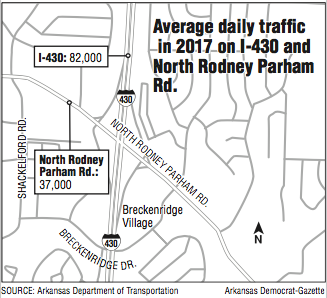Adding another left-turn lane and other improvements to the busy Interstate 430/North Rodney Parham Road interchange in west Little Rock will cost nearly $3.2 million.
The project was one of 45 on which the Arkansas Department of Transportation opened low bids worth $40.2 million.
The work included eight state highway projects on which low bids worth $30 million were opened, as well as 13 city street projects worth $4.7 million and two dozen county road projects worth $5.5 million. The bids won't become official until agency officials review them for accuracy.
The I-430/North Rodney Parham interchange is one of three projects that are addressing interchanges on the I-430 corridor through west Little Rock, the state's most populous city.
The department spent $124 million to upgrade the I-430/I-630 interchange. The work was spread over three projects, the last of which was completed in 2015.
Work on an estimated $58 million job to improve the I-430 interchange at Cantrell Road is expected to begin in 2021.
The department initially looked at a more ambitious design to address traffic congestion at the Rodney Parham interchange, where 82,000 vehicles pass daily on I-430 and 37,000 cross it daily on the city street, according to agency data.
Four years ago, department engineers drew up a design to convert the junction into a diverging diamond interchange in which the two directions of traffic on Rodney Parham would cross to the opposite sides of the overpass.
Traffic in the westbound lanes would be channeled to the eastbound at traffic lights on both ends of the overpass and traffic in the eastbound lanes would be channeled to the westbound lanes.
The configuration would eliminate the need for left- turn lanes, which engineers identified as a major source of traffic backup in the interchange at peak travel times.
But eliminating backups on the interstate would create other backups on Rodney Parham that would extend well beyond the interchange.
"There's too much traffic on Rodney Parham," said Bill Henry, traffic engineer for the city. "Traffic models show it would back up for miles. It ended up making more sense to do a standard interchange."
The project on which engineers ultimately settled was to add a second left-turn lane for traffic traveling west on Rodney Parham and wanting to go south on I-430, which is the same option already available in the interchange for motorists traveling east on Rodney Parham and wanting to go north on I-430.
"It's a simple job," said Danny Straessle, a department spokesman.
The project also will replace the traffic signals at both ends of the interchange, remove raised medians in the interchange and install a sidewalk on the south side of the interchange, he said. The addition of the sidewalk also requires replacing the parapet on the south side with a taller one to better protect pedestrians.
The low bid for the actual work, submitted by Kiewit Infrastructure South Inc. of Fort Worth was higher than the only other bid opened, $2.86 million from Mobley Contractors Inc. of Morrilton. Township Builders Inc. of Little Rock obtained the plans for the project, but didn't submit a bid.
But Kiewit said it could do the work in far less time -- 71 days -- than the time Mobley said it needed -- 213 days.
The amount of time is an element of bids on projects on heavily traveled routes and calculated as a cost to motorists, in terms of delays, fuel consumption and wear and tear on vehicles. When the time is calculated, Kiewit's bid amount for "award consideration" was equivalent to $3.9 million versus $5.2 million for Mobley.
Little Rock has "partnered" with the department to help pay for the project. The city is contributing $750,000, Straessle said.
Metro on 06/14/2018
